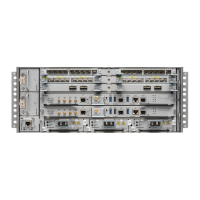The router supports three power supply units that can be used either in 2+1 or 1+ 1 modes, depending on the
overall power requirement of the system.
The Cisco NCS 560-4 Router supports current sharing between the power supplies.
If you install a redundant power supply on the Cisco NCS 560-4 Router, we recommend that you connect
each power supply to a separate input power source in order to ensure that the router maintains power in the
event of a power interruption caused by an electrical failure, a wiring fault, or a tripped circuit breaker.
Status LEDs
LEDs are also provided on each power supply to indicate the status of the input power and the health of the
power supply.
Network Timing Interfaces
The route processor supports the following network timing interfaces:
• BITS input/output port—RJ48 jack
• 1PPS input and output—Mini coaxial connectors
• 2.048 or 10 MHz input and output—Mini coaxial connectors
• 1PPS input or output port—Shielded RJ45 jack
Network timing interfaces support redundancy in a redundant RSP configuration. Network timing interfaces
on a redundant RSP remain in operation while the RSP is in hot standby mode.
Online Insertion and Removal (OIR)
The following table describes the parameters for the OIR of the various modules in the router.
Table 5: Online Insertion and Removal - Parameters
CommentsOIR TimeFan SpeedAmbient
5
OIR Module
Single Fan Fail,
Other Fans running
at 100% PWM
5 mins100% PWM30°CFan Tray
6
3 mins100% PWM40°C
Fans running at
normal speed
5 mins
As per the fan
algorithm
40°CPSU
Interface Module
7
RSP
5
It is not recommended to perform OIR of any module above 40°C ambient
6
Fan Tray OIR should be performed only when a fan's failed condition is encountered and other fans are
spinning at max speed.
7
It is recommended to shut down the interface modules before attempting to remove them from the
chassis.
Cisco NCS 560-4 Router Hardware Installation Guide
12
Cisco NCS 560-4 Router Overview
Network Timing Interfaces

